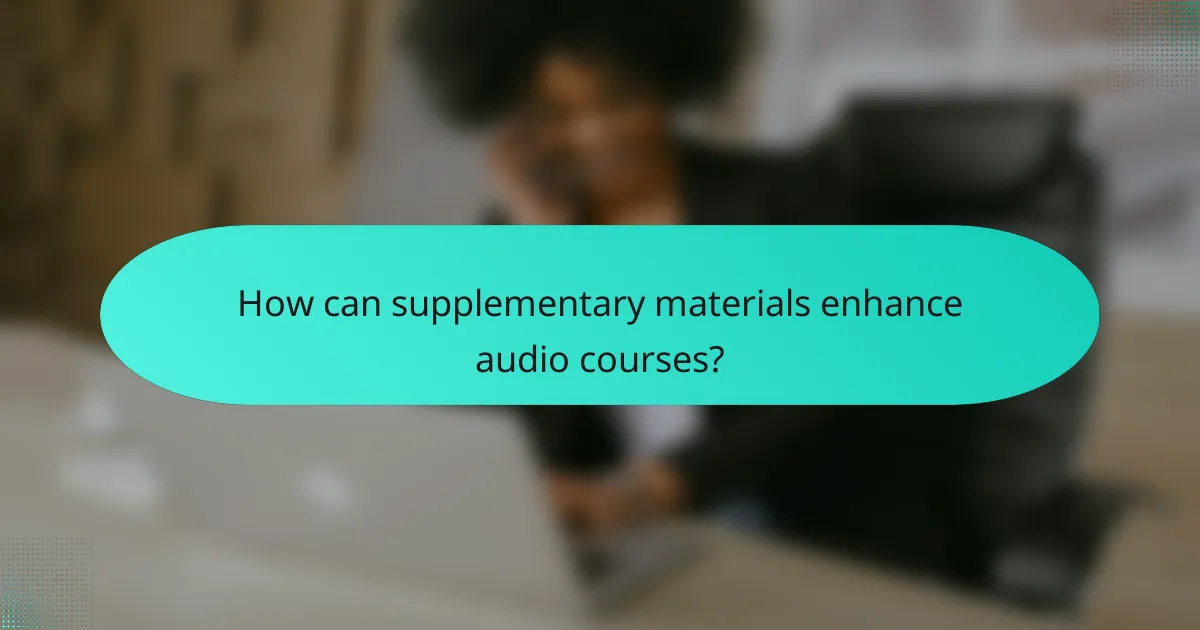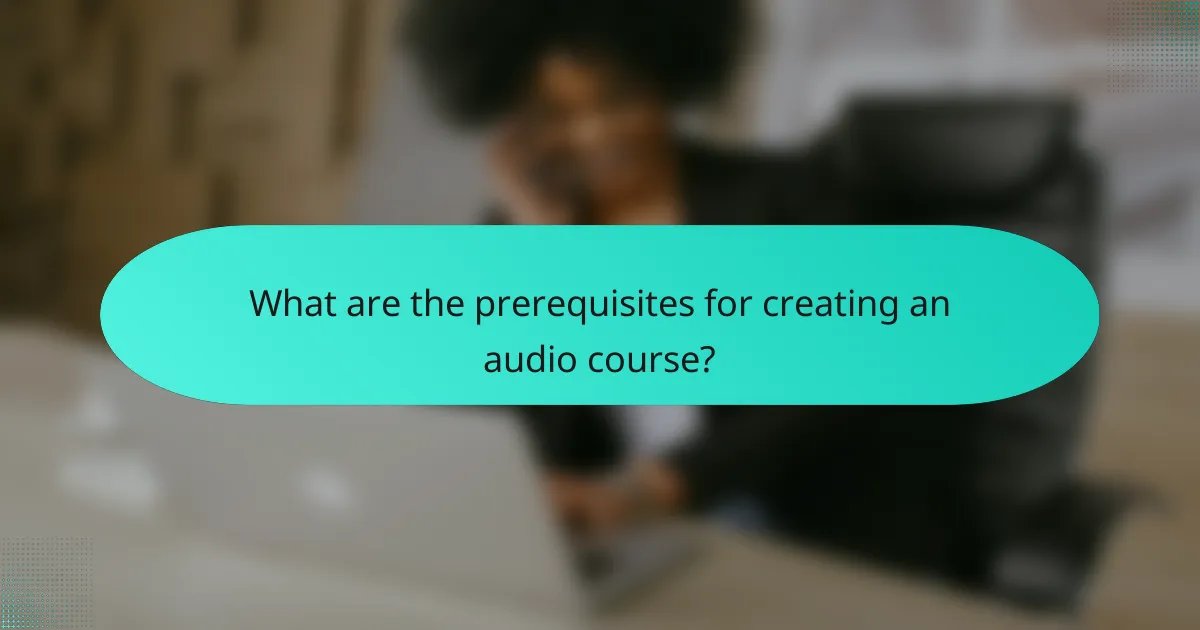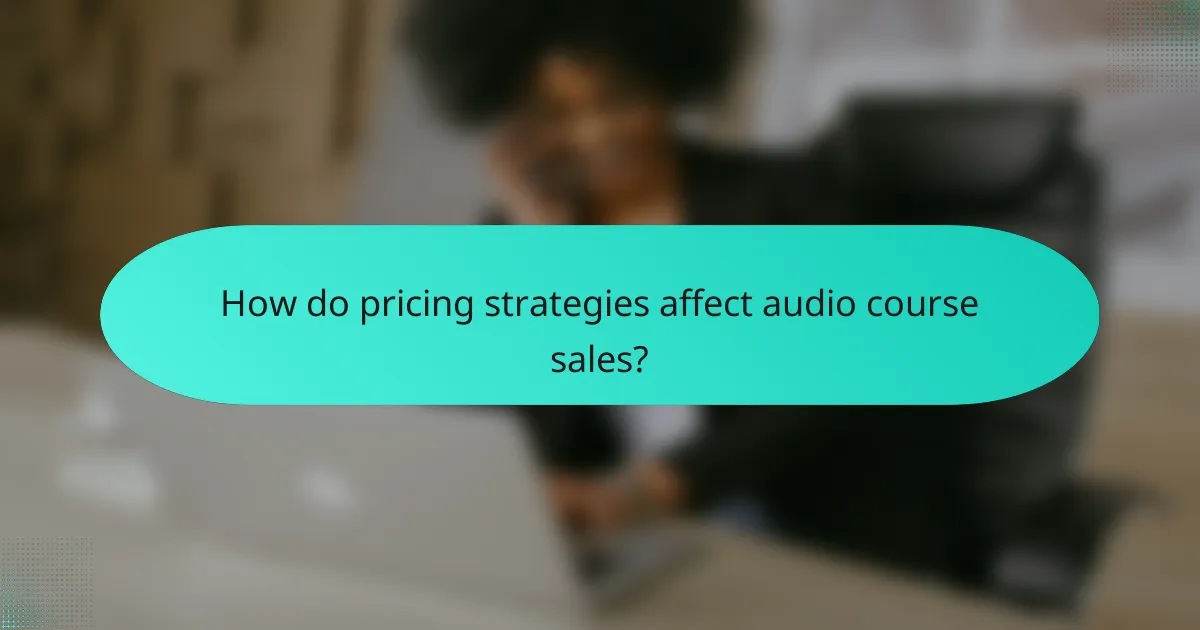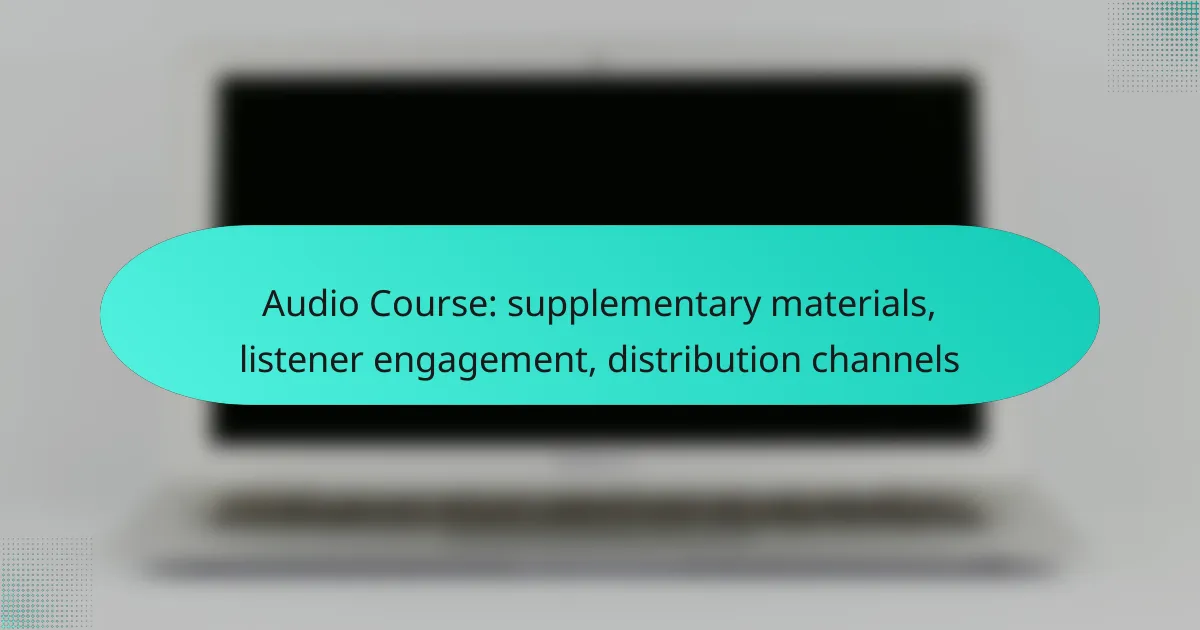Audio courses can be greatly enhanced with supplementary materials that provide context and reinforce learning, ultimately improving listener retention. Engaging listeners through personalized experiences and interactive strategies is crucial for fostering a deeper connection with the content. Additionally, selecting the right distribution channels, such as podcast platforms and social media, ensures that your audio course reaches and resonates with the intended audience.

How can supplementary materials enhance audio courses?
Supplementary materials can significantly enhance audio courses by providing additional context, reinforcing learning, and improving engagement. These resources help listeners retain information and apply what they’ve learned more effectively.
Interactive PDFs
Interactive PDFs can serve as dynamic learning tools that complement audio content. They allow users to engage with the material through clickable links, embedded multimedia, and fillable forms. This interactivity can keep learners focused and enhance their understanding of complex topics.
When creating interactive PDFs, consider including features like quizzes, note-taking sections, or links to further reading. Ensure that the design is user-friendly and visually appealing to maximize engagement.
Companion workbooks
Companion workbooks provide structured exercises and activities that align with the audio course content. They can include prompts for reflection, practical applications, and space for personal notes. This hands-on approach encourages learners to actively engage with the material.
To create effective workbooks, focus on clear instructions and relevant exercises that reinforce key concepts. Consider varying the types of activities to cater to different learning styles, such as visual, auditory, and kinesthetic.
Quizzes and assessments
Quizzes and assessments are essential for gauging learner comprehension and retention. They can be used to reinforce key points and provide immediate feedback, helping learners identify areas for improvement. Incorporating these tools can increase motivation and accountability.
When designing quizzes, aim for a mix of question types, such as multiple-choice, true/false, and short answer. Keep assessments concise to maintain engagement, and consider offering instant results to enhance the learning experience.
Resource lists
Resource lists offer learners additional materials for deeper exploration of topics covered in the audio course. These can include articles, books, videos, and websites that provide further insights or practical applications. Curating a well-rounded list can enrich the learning experience.
When compiling resource lists, prioritize high-quality, relevant materials. Organize the list by topic or difficulty level to help learners navigate their options easily. Providing links to online resources can also facilitate access.
Transcripts and summaries
Transcripts and summaries provide written versions of the audio content, making it easier for learners to review and reference key points. They can serve as study aids and help reinforce understanding, especially for auditory learners who benefit from reading along.
Ensure that transcripts are accurate and well-formatted for easy reading. Summaries should highlight the main ideas and key takeaways, allowing learners to quickly grasp the essential information without re-listening to the entire audio course.

What strategies improve listener engagement in audio courses?
Improving listener engagement in audio courses involves creating interactive and personalized experiences that resonate with learners. Strategies such as personalized content recommendations, community forums, live Q&A sessions, and feedback surveys can significantly enhance engagement levels.
Personalized content recommendations
Personalized content recommendations tailor the learning experience to individual preferences and needs. By analyzing listener behavior and interests, platforms can suggest relevant courses or topics, increasing the likelihood of continued engagement.
For instance, if a user frequently listens to marketing-related content, the platform might recommend advanced marketing strategies or related subjects. Implementing algorithms that track user interactions can help refine these suggestions over time.
Community forums
Community forums foster a sense of belonging among learners, allowing them to share insights, ask questions, and discuss course materials. These forums can be integrated into the course platform or hosted on social media groups, encouraging interaction outside of the audio sessions.
To maximize effectiveness, moderators can facilitate discussions and ensure that conversations remain constructive. Encouraging users to share their experiences and tips can also enhance the learning environment.
Live Q&A sessions
Live Q&A sessions provide an opportunity for learners to engage directly with instructors or industry experts. These interactive sessions can clarify complex topics and allow for real-time feedback, making the learning experience more dynamic.
Scheduling these sessions at convenient times for the target audience can boost participation. Consider using platforms that allow for easy access and recording options, so those who cannot attend live can still benefit from the content.
Feedback surveys
Feedback surveys are essential for understanding listener preferences and improving course offerings. By regularly collecting input on course content, delivery, and overall satisfaction, course creators can make informed adjustments to enhance engagement.
Surveys should be concise and focused, ideally taking no longer than a few minutes to complete. Offering incentives, such as discounts on future courses, can encourage higher response rates and more honest feedback.

Which distribution channels are most effective for audio courses?
The most effective distribution channels for audio courses include podcast platforms, online course marketplaces, social media channels, and email newsletters. Each channel offers unique advantages for reaching and engaging listeners, making it essential to choose the right mix based on your audience and content type.
Podcast platforms
Podcast platforms are among the most popular channels for distributing audio courses. They allow creators to reach a broad audience through established networks like Apple Podcasts, Spotify, and Google Podcasts. Consider optimizing your audio course for these platforms by ensuring high-quality audio and engaging content.
When using podcast platforms, focus on creating a compelling title and description to attract listeners. Regularly releasing episodes can help build a loyal audience, as consistency is key in maintaining listener engagement.
Online course marketplaces
Online course marketplaces such as Udemy, Coursera, and Skillshare provide a structured environment for audio courses. These platforms often handle marketing and distribution, allowing creators to focus on content development. They typically charge a fee or take a percentage of sales, so it’s important to understand their pricing models.
Utilizing these marketplaces can enhance visibility, as they attract users actively seeking educational content. Ensure your course is well-structured and includes supplementary materials to enhance the learning experience.
Social media channels
Social media channels like Facebook, Instagram, and LinkedIn can be effective for promoting audio courses. These platforms allow for targeted advertising and community engagement, helping you connect with potential listeners. Share snippets or highlights from your audio course to generate interest.
Engagement is crucial on social media; respond to comments, create polls, and encourage discussions to foster a community around your content. Consider using paid ads to reach a wider audience, especially if you have a specific target demographic.
Email newsletters
Email newsletters are a direct way to reach your audience and promote your audio courses. Building a subscriber list allows you to share updates, exclusive content, and course announcements directly with interested listeners. Regular communication can help maintain engagement and encourage course sign-ups.
When crafting your newsletters, keep the content concise and valuable. Include links to your audio courses, testimonials, and any upcoming events. Segment your audience to tailor messages based on their interests for better results.

What are the prerequisites for creating an audio course?
Creating an audio course requires a clear understanding of your target audience, a well-structured content outline, and the necessary technical setup. These prerequisites ensure that your course is engaging, informative, and accessible to listeners.
Target audience analysis
Understanding your target audience is crucial for creating an effective audio course. Identify their demographics, interests, and learning preferences to tailor your content accordingly. Consider conducting surveys or interviews to gather insights directly from potential listeners.
Once you have a clear profile of your audience, you can create content that resonates with them. For example, if your audience consists of busy professionals, focus on concise, actionable lessons that can be consumed during commutes.
Content outline development
A well-organized content outline serves as the backbone of your audio course. Start by defining the main topics you want to cover and break them down into manageable lessons. Each lesson should have a clear objective and key takeaways to facilitate learning.
Consider using a hierarchical structure for your outline, where broader topics are subdivided into specific subtopics. This approach helps maintain a logical flow and keeps your audience engaged throughout the course.
Technical setup requirements
To produce high-quality audio content, you need the right technical setup. Invest in a good microphone, headphones, and audio editing software to ensure clear sound and professional production quality. A quiet recording environment is also essential to minimize background noise.
Familiarize yourself with audio formats and platforms for distribution. Common formats include MP3 and WAV, while platforms like Podbean or Anchor can help you reach a wider audience. Ensure that your technical setup aligns with the distribution channels you plan to use.

How do pricing strategies affect audio course sales?
Pricing strategies significantly influence audio course sales by determining perceived value and accessibility. Effective pricing can attract a wider audience while maximizing revenue potential.
Tiered pricing models
Tiered pricing models offer different levels of access at varying price points, catering to diverse customer needs. For example, a basic tier might include essential course materials, while higher tiers could offer additional resources like one-on-one coaching or exclusive content.
This approach can increase sales by appealing to both budget-conscious learners and those willing to invest more for enhanced experiences. Consider offering three tiers: basic, standard, and premium, with price differences reflecting the added value of each level.
Subscription options
Subscription options allow users to pay a recurring fee for ongoing access to audio courses. This model can create a steady revenue stream while encouraging long-term engagement with the content.
For instance, a monthly subscription could provide access to a library of courses, while an annual plan might offer a discount. This strategy can attract learners who prefer flexibility and continuous learning without a large upfront investment.
Discounts and promotions
Discounts and promotions can effectively boost audio course sales, especially during key periods like holidays or back-to-school seasons. Offering limited-time discounts can create urgency and encourage potential buyers to act quickly.
Common strategies include percentage-off promotions, bundled offers, or referral discounts. For example, a 20% discount for first-time buyers can incentivize new customers to try your courses, while a referral program rewards existing users for bringing in new learners.
